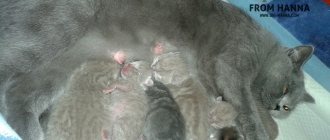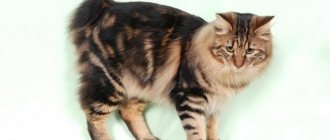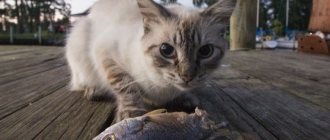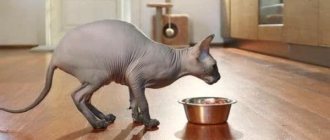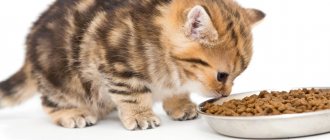Bengal kittens have become popular. People from all over the world are increasingly buying them, and the new breed is conquering more and more people. The owners immediately have a logical question - what to feed their Bengal kittens.
The breed appeared in the last century, it combines the habits of a pet and the body of a predator, with characteristic spots.
What to feed Bengal kittens
Even a person who does not often encounter animals will notice that Bengal cats are different from their four-legged counterparts. Given their wild nature, kittens require special care and want a lot of attention. We will separately consider what to feed such animals.
Bengal cat - features of the breed
The potential owner should study the breed characteristics of the future pet. First of all, you should know about all the nuances related to health and care. In general, Bengal cats are characterized as potentially healthy animals. The level of activity of adult animals is average, but up to the age of one year, kittens are very restless.
Genetic diseases that are not affected by diet and care are:
- Hypertrophic cardiomyopathy is a congenital cardiac anomaly.
- Leukemia is a severe, chronic and often fatal blood disease.
Bengals are prone to viral and colds, especially if there are relatives in the family tree (this happens often). Representatives often experience an unexplained decrease in immune defense, which can be either temporary or chronic.
Veterinarians believe that the quality of care and diet influence sudden changes in the functioning of the immune system.
It is known that Bengal cats quickly adapt to new living conditions. If an adult cat is not provoked to activity, it will sleep most of the day. Calorie feeding without exercise is a direct path to obesity, heart disease and diseases of the musculoskeletal system.
The last thing that needs to be taken into account is the tendency of representatives of the breed to sensitivity and various diseases of the gastrointestinal tract. The development of such pathologies is influenced by the quality and balance of the diet.
A few words about care
Most new owners are constantly worried about what to feed their Bengal kitten. The peculiarities of caring for a purebred pet also raise many questions, although in fact, Bengals do not cause almost any trouble in caring for them.
The kids are playful, quickly trainable and understand all the commands of their owners. If you teach them to follow certain rules from an early age, you will get an obedient adult cat with a balanced character.
Bengals love cleanliness, so their litter box should always be thoroughly cleaned. It is best to choose wood litter, since cats of this breed love to bury their excrement and cannot stand foreign odors.
From their wild ancestors they inherited a love of water and walks, so be prepared to purchase a harness and give your pet good exercise at least once a week. Kittens love to splash and splash water, they even drink it after carefully pushing away the non-existent dirt with their paws. In this regard, children should change the drinking water in the bowl at least twice a day.
Mini leopards are great at grinding their claws off on their own, but their ears and eyes need to be kept clean. It is enough to wipe them daily with a soft cloth.
As you can see, cats of this breed do not cause much trouble, but I would like to talk in more detail about their feeding. What to feed a Bengal kitten? The question is not an idle one, because the pet’s mood and health depend on the diet. Let's look at this topic.
Choosing a place and utensils for feeding
After moving to a new home, the kitten is stressed, although it may not show it outwardly. Separation from the mother and change of environment can turn stress into physical illness. To simplify the adaptation process, the future owner needs to prepare the conditions for the kitten in advance.
The choice of place and utensils for feeding plays an important role in the adaptation of the pet. While eating, the kitten should feel comfortable and safe. If you have other pets in the house, try to feed the newbie separately so he doesn't have to compete for food.
The eating area should be comfortable for the pet and clean. To make cleaning easier, you can place a small rubber mat under the bowls. The rubber coating is easy to clean; in addition, the mat prevents the kitten from slipping if he is in a hurry to get to the bowl.
Give preference to ceramic or stainless steel bowls. The downside of ceramic bowls is that they break when dropped from a height. The advantages include ease of care and significant weight - ceramic bowls do not slip. Stainless steel bowls are unbreakable and can be treated with boiling water. However, steel bowls are lightweight, so they need to be placed on a stand.
Water
At any age, regardless of the type of Bengal diet, drinking water should always be freely available in the bowl. Do not give your cat water from the tap. It contains chlorine and other chemical compounds that are unsafe for animals.
Veterinarians recommend using pre-settled, filtered soft drinking water for kittens to drink. You can also give your kitten bottled artesian water without gas.
Always wash bowls before adding water. The water is changed once or twice every knock. Make sure that there are no food particles, insects, or other third-party particles in it.
What to feed a Bengal kitten - choosing the type of diet
You can feed your Bengal kitten using different types of feeding:
- Natural.
- Industrial.
- Mixed.
When making a choice, you need to rely on the needs of the pet and your capabilities. Frequent changes in diet have a negative impact on your pet's health. According to the recommendation of veterinarians, it is better not to change the type of diet until the age of one year. However, if the kitten has moved to a new home and is accustomed to a type of food that does not suit you, the diet can be changed after an adaptation period.
Natural diet
A natural diet is considered more natural for pets. Absolutely all manufacturers of dry food strive (as they are not shy about saying in advertising) to produce products that are as similar as possible to natural food.
A natural diet for a Bengal kitten includes:
- Feeding raw and cooked foods in pure and mixed form.
- Feeding exclusively raw foods is a raw food diet.
- Feeding with homemade semi-finished products.
Benefits of a natural diet:
- Food is better absorbed even by animals with sensitive digestion.
- You can control the freshness and quality of the products.
- If you experience food allergies or don’t think about mysterious ailments of the gastrointestinal tract, you can easily choose a gentle diet.
- You can adjust the calorie intake depending on the season of the year and the activity of your pet.
- A natural diet is 2–3 times cheaper than ready-made food of similar quality.
- A natural diet involves regular vitamin courses.
Disadvantages of a natural diet:
- Natural food spoils quickly, so you need to cook it regularly for your pet, which costs time.
- Natural food should not be left in an automatic feeder.
- A natural diet involves regular vitamin courses.
A Bengal kitten can be switched to a natural diet from the age of one month. Until 4–4.5 months, babies eat soft and liquid food.
Until about 10 months of age, kittens willingly consume almost all products offered to them. From the age of one, a cat develops taste preferences that are very difficult to change.
Ready-made feed
Dry canned commercial cat foods are becoming increasingly popular. Most likely, the reason is that the pace of life of owners is constantly accelerating and there is simply no time left to prepare natural food for their pet. The ready-made food market is replete with assortment, but not all products are suitable for a Bengal kitten, especially if the animal has a tendency towards chronic pathologies.
Ready-made feeds are divided into types:
- Dry – granules.
- Semi-moist - pieces with gravy or jelly.
- Wet - pate or paste.
Food manufacturers and veterinarians do not recommend feeding domestic cats only one type of food.
- For adult animals, a diet of 75% dry and 25% wet food is recommended.
- For kittens, the mass fraction of wet food should be at least 50–60%.
The key factor when choosing food for your pet is its quality or class:
- Economy
- Premium
- Super premium.
- Holistic.
Super-premium and holistic class foods are suitable for feeding Bengal cats.
If your pet is young, healthy and active, food from the everyday line will be suitable for him. If the animal has chronic pathologies or tendencies to them, it is necessary to choose products from lines for animals with special needs:
- Supportive.
- Preventive.
- Medicinal.
- For exhausted kittens and adult animals.
- Hygienic (usually treats).
Advantages of ready-made feed:
- Significant time savings.
- Dry food can be left in an automatic feeder so that your pet can eat while you are at work.
- Holistic and super-premium food contains a basic complex of vitamins.
Disadvantages of ready-made feeds:
- Feeding high-quality finished products costs several times more than a natural diet.
- There is always a risk of buying counterfeit food, which threatens the health of your pet.
- If an allergy or sensitivity of the digestive tract is detected, the cat must be switched to preventive food, which is more expensive than the daily line.
If a kitten is deprived of maternal care, it can be fed with an industrial cat's milk substitute from the first day of life. Supplementary feeding from ready-made feed is introduced in the first month of life.
Until the complete change of teeth, the kitten should receive soft food: canned food and soaked dry food. After changing baby teeth, dry food can be introduced into the Bengal kitten's diet.
Mixed diet
Many owners consider a mixed diet a convenient and affordable option for feeding their pet. A mixed menu involves feeding industrial and natural products. Feed manufacturers and veterinarians recommend refraining from mixed feeding, since such a diet is fraught with the development of dysbiosis.
The main problem is that the cat's digestive system adapts to digest food of a certain structure. Dry food and natural products have different structures and take different amounts of time to digest. With mixed feeding, some of the food is not digested, but rots, which leads to the death of colonies of friendly bacteria.
Mixed feeding is considered acceptable if high-quality canned food is added to natural food. Mixed feeding can be a temporary measure, for example, when transferring a cat from a natural to an industrial diet.
Natural food
Meat should be the basis of nutrition for animals of this breed.
If feeding a Bengal is based on natural products, the risk of dehydration of his body is reduced: even with a reduced intake of drinking water, the cat receives liquid from meat and vegetables. Properly selected natural food helps reduce the risk of developing urolithiasis and diabetes, and prolongs the life of your pet. The optimal diet for an animal is meat and vegetable supplements. This mixture of products will ensure normal functionality of the gastrointestinal tract.
Veterinarians recommend introducing new types of food into the menu gradually and carefully. It is desirable that the prepared diet does not change throughout the animal’s life. Before introducing a new type of product into a Bengal cat’s diet, it is advisable to test it in small quantities: add a little to the food and watch the pet’s reaction.
Contraindicated:
The diet of these animals should not include duck.
- Fatty meat: pork;
- duck;
- goose;
- mutton;
- turkey meat.
Recommended food
An adult pet is fed 2-3 times. per day, in one serving 200-400 g of food. Recommended types of food for a Bengal cat:
These fluffies can be treated to carrots.
- Raw lean meat - at least 70% of the daily portion. It is useful to give chicken, rabbit, veal. To prevent the animal from becoming infected with parasites, it is recommended to store meat in deep freeze. Before eating, cut into small pieces, but do not grind into mince, and pour over boiling water.
- Meat by-products: chicken gizzards;
- heart;
- lungs;
- some liver.
- bird's neck;
- pumpkin;
- buckwheat;
Sample menu by age
By drawing up an approximate menu by age, you can sensibly assess your physical and financial capabilities. It is important to remember that it is advisable not to change a kitten’s diet until it is one year old. Valid reasons for a sudden change in diet are considered to be: feeding with economy class feed and an unbalanced natural diet.
Up to 1 month
Until the age of one month, kittens feed exclusively on their mother's milk. In the first few days of life, kittens feed on colostrum, which contains antibodies, a large amount of proteins and friendly bacteria. If a kitten, for some reason, is deprived of maternal care, it is fed artificially.
Natural menu:
- Goat milk diluted with boiled water.
- Scott's kitten mix.
- Tiling mix for kittens.
Industrial menu:
- Cat milk replacer.
- From 1.5–2 weeks – infant formula “from 0” (without additives and sugar).
The daily food intake for a Bengal kitten under one month of age ranges from 30 to 50 ml.
Number of feedings:
- From birth to 2 weeks - every 2 hours, a total of 10 times a day.
- From 2 to 4 weeks - every 2-3 hours, a total of 8 times a day.
When artificially feeding a kitten under one month of age, many veterinarians recommend focusing on the baby’s behavior. If the kitten squeaks, it means he is hungry.
With this approach, you can overfeed the baby, since squeaking can indicate both hunger and stress. The only way to monitor height and weight gain is to weigh the kitten regularly.
1 month
At 1 month, kittens begin to open their eyes and leave the nest. Babies' hearing and sense of smell become more acute, they begin to become interested in the outside world and the smell of the food that the mother cat eats. To encourage the kittens' interest, the breeder introduces supplementary food into their diet.
Natural menu:
- Mother's milk.
- Whole goat or cow's milk.
- Low-fat beef broth.
- Boiled minced meat mixed with broth and homemade meat pate.
Industrial menu:
- Cat milk replacer or infant formula.
- In case of growth retardation - pate for emaciated kittens.
The daily food intake ranges from 40–80 grams.
Number of feedings: 6–7 times a day, excluding mother’s milk.
2 months
At 2 months, kittens have a full set of baby teeth and learn to chew. However, babies try to stay close to their mother and milk makes up the bulk of their diet.
Natural menu:
- Mother's milk or natural substitute.
- Whole cow's or goat's milk.
- Calcined cottage cheese.
- Dairy products.
- Bouillon.
- Boiled minced meat (carefully chopped).
- Chopped, raw, boiled or pre-frozen meat (beef).
Industrial menu:
- Cat milk replacer or infant formula.
- Canned food for kittens.
The daily food intake for a Bengal kitten at the age of 2 months directly depends on body weight and ranges from 40–90 grams.
The number of feedings varies from 5 to 6 times a day.
3 months
At 3 months, a Bengal kitten will face a number of stresses: primary vaccination, anthelmintic measures and moving to a new home. Against the background of changes, the kitten's appetite may worsen and there may be a slight stagnation in weight gain. This reaction of the body is considered natural.
Natural menu:
- Mother's milk or its substitute.
- Whole milk, fermented milk products, calcined cottage cheese.
- Boiled minced meat, raw, chopped meat.
- The broth is low-fat, pure or with egg.
- Raw quail eggs or chicken egg yolk. Can be mixed with cottage cheese.
- Raw grated carrots, a little green apple.
Industrial menu:
- Cat milk replacer or infant formula.
- Canned food for kittens.
- Semi-moist food for kittens.
The serving size for a Bengal kitten at the age of 3 months remains the same, but due to the increased nutritional value, the baby remains full longer. Number of feedings at the age of 3 months: 5–6 times a day.
4–6 months
At the age of 4–6 months, the kitten’s body prepares for a change of teeth. In addition, the Bengal kitten becomes more active and curious, which means an increase in calorie needs.
Natural menu:
- Whole milk, fermented milk products, cottage cheese - in large quantities.
- Boiled and raw meat without fat and bones - beef, veal, rabbit.
- Ocean fish, low-fat - chopped, deboned, boiled or after deep freezing.
- Beef or poultry by-products, boiled, chopped.
- Chicken and quail eggs – raw, boiled, scrambled eggs (without oil). Can be mixed with vegetables or dairy products.
- Vegetables – raw, grated.
Industrial menu:
- Pates.
- Semi-moist food.
- Soaked dry food.
The daily food intake for a Bengal kitten aged 4–6 months ranges from 80–120 grams.
Number of feedings at the age of 4–6 months: 4–5 full meals and 2 light snacks.
From 6 months to 1 year
At the age of 6 months to 1 year, the kitten completes the replacement of milk teeth and the final taste preferences are formed. During this period, it is extremely important to tame your pet to healthy foods if you prefer a natural diet.
Natural menu:
- Meat – beef, poultry, rabbit.
- Meat by-products – beef, poultry.
- Homemade milk.
- Fermented milk products - any, preferably homemade.
- Fish and seafood.
- Fish and meat broths.
- Chicken and quail eggs.
- Vegetables are raw.
- Fruits are not sweet, little by little (as a source of vitamins).
- Greenery, grass.
- Cereals - only with increased activity, stunted growth and obvious lack of saturation with a diet without grains.
Industrial menu:
- Until the complete change of teeth (7–8 months) - wet and semi-moist food for kittens of active breeds, soaked dry food.
- After a complete change of teeth - 75% dry and 25% wet or semi-moist food.
The serving size for a Bengal kitten is determined according to needs, depending on the degree of activity. The final daily food intake is determined individually and ranges from 140 to 200 grams.
The number of feedings is gradually reduced to 2–3 times.
Other recommendations
When a kitten is weaned from its mother's breast, it is especially necessary to carefully monitor its nutrition. Typically, Bengals from three years old are fed five times a day in small portions. Its size, sexual function, activity and health will depend on a balanced and healthy diet (see size and weight of a Bengal cat).
But you shouldn’t think that if the kitten has grown up healthy and beautiful, then you can give up on its nutrition. His further appearance and well-being depend on this.
Vitamins and supplements
When feeding with high-quality, industrial feed, vitamins and additives are not introduced into the diet. Additional sources of nutrients are necessary if you prefer natural feeding. Even the highest quality and freshest products cannot compensate for the needs of active cats.
Natural vitamin supplements:
- Meat and bone meal.
- Fish, chicken, beef liver.
- Greens, vegetables, fruits.
- Sunflower oil, olive oil.
- Brewer's yeast.
Pharmacy vitamin supplements:
- Fish fat.
- Feed tricalcium phosphate.
- Omega-3, Omega-6.
- B vitamins.
In addition to vitamins and minerals, cats need taurine. Unlike dogs, which synthesize taurine naturally, cats can only obtain this amino acid from food.
Sources of taurine:
- Turkey.
- Rabbit.
- Chicken heart, liver.
- Beef heart.
- Pork, ham, trimmed of fat, after deep freezing.
- Pork liver, heat-treated.
- Ocean fish, shellfish.
- Raw red fish.
- Homemade live yogurt.
- Whole milk.
To make life easier, the owner can conduct vitamin courses using special, industrial supplements. Vitamin complexes are sold in pet stores and veterinary pharmacies, usually available in the form of tablets or powders.
What natural food should be:
- Meat should make up 80% of your cat's daily food intake.
- Do not give your kitten fatty foods (pork, lamb, butter).
- The kitten meat needs to be boiled and cut into pieces.
- Partial replacement of meat with liver and heart is allowed (1-2 times a week).
- Fish for kittens should be given boiled and without bones; red fish (salmon, trout, pink salmon) is the healthiest.
- Cook porridge for the kitten (buckwheat, oatmeal, wheat).
- The kitten should be given chopped boiled vegetables (everything except potatoes). You can immediately prepare vegetable porridge.
- Give milk with caution; sometimes you can give cream. But it is better to accustom your baby to fermented milk products (kefir, fermented baked milk, sour cream).
- Give your Bengal a complex of vitamins and calcium supplements.
For natural food recipes for Bengal cats, see our article.
Natural nutrition for Bengal kittens
Prohibited Products
It is important to exclude prohibited foods from your Bengal kitten’s diet:
- Bones, pure fat, skin, especially poultry.
- Palm oil.
- Grapes, raisins.
- Juicy and sweet fruits.
- Soy.
- Mushrooms.
- Corn and semolina.
- Raw freshwater fish.
- Dry, salted fish.
- Smoked products, including sausages, balyki, fish.
- Products containing sugar or its substitutes, xylitol (chewing gum, some sweets), flour or yeast, caffeine, cocoa, any stimulants (sweets, tea, coffee, chocolate), marinades, salt, spices.
- Dog food.
- Expired products.
- Leftovers from the table.
Controversial foods in the diet of a Bengal kitten are:
- Fresh pork is a source of helminths and false rabies.
- Raw ocean fish are a source of helminths.
- Whole milk – risk of individual intolerance.
- Chicken eggs are an allergen.
- Factory-bred chicken – risk of allergies and individual intolerances.
- Raw and boiled chicken liver in large quantities.
- Cereals.
Most veterinary nutritionists do not recommend including grains or additional sources of carbohydrates in a cat's diet.
The reason is that the cat’s body synthesizes enough carbohydrates to nourish the nervous system, and additional intake can lead to excess weight gain. However, if your pet is active and does not gain weight well, you can add buckwheat or rice to its diet.
Natural food vs. prepared food
These debates have been going on for many years and continue to this day. Some people are sure that only meat, grains and vegetables fully cover the Bengal cat’s need for calories, proteins and vitamins. Other breeders believe that only good ready-made food will protect their pets from indigestion and other common problems.
Unfortunately, even veterinarians cannot yet say with certainty which approach is more correct. On the one hand, the diet of a Bengal cat should indeed include meat, since wild genes are strong in them. On the other hand, their stomach is actually very sensitive and reacts poorly to changes in food, new, unusual foods, even slightly spoiled food, and so on.
Therefore, the conclusion is this: if you are ready to take on the responsibility of creating a balanced diet for your Bengal cat, this is a great option. If you are looking for a simpler option, it is better to rely on manufacturers of ready-made food.
The Bengal's sensitive digestion does not tolerate changes in food very well. It can be done only when absolutely necessary and gradually.
What is suitable from natural food?
When taking a Bengal animal into the house and planning to feed it natural products, the owner must know whether regular food is acceptable for him and in what form.
- Some believe that a natural predator should eat only raw meat, but in fact, beef, rabbit, and poultry can be boiled, stewed, used in the form of pieces or minced meat. Raw pieces must be scalded before serving.
- By-products - veal liver, lungs or chicken offal - are given once every 7 days to diversify the diet.
- Suitable fish for the cat's table are navaga, pollock, and tuna. From the age of one year, it is allowed to give herring or salmon occasionally (once a week).
- Oatmeal is considered healthy for your pet's body, as are rice and buckwheat, but it should be cooked in lean beef broth. Then add minced meat or fish and chopped herbs to the dish.
- Porridge and cooked vegetables can be seasoned with vegetable oil - flax, sunflower, olive - these are sources of tocopherol.
- Little kittens and adult pets enjoy eating sprouted grains of wheat, oats and cat grass. It is easy to grow these plants at home, which are so beneficial for your pet. They help get rid of pieces of wool in the digestive tract and saturate the body with vitamins.
A Bengali's diet must include vegetables and greens, with the exception of cabbage, which causes bloating.
Fermented milk products are also desirable, especially cottage cheese, fermented baked milk and kefir. You can also give milk, but only if it does not provoke vomiting or diarrhea.
Prohibited
Under no circumstances should animals do the following:
- Fatty meat - duck, goose, lamb, especially pork, because it contains parasite eggs.
- River fish - small bones scratch the intestines and are not digested.
- Sweets, especially chocolates.
- Spicy, salty and smoked. This leads to diseases of the genitourinary system.
- Potatoes because they contain starch.
- Legumes lead to gas formation.
- Spices - their strong smell can impair your sense of smell, and they also disrupt your metabolism.
Kittens up to two months are fed six times a day; by six months the number of meals is reduced to three. It is better to put food in a bowl according to a schedule; it should be at room temperature and always fresh. It is better to throw away the uneaten food. You cannot combine industrial food and natural food.
Sterilized
Adult sterilized individuals of both sexes need fewer calories than those whose reproductive function is being realized. Buy special dry food, do not overfeed, otherwise it will lead to obesity and problems with health and the genitourinary system. In natural food, also reduce the number of calories, you can completely eliminate cereals and try to reduce fat consumption to a minimum, although you cannot do without them completely.
Remember to constantly change the water and turn on the tap occasionally. Some believe that such animals live longer, they have a lower risk of developing tumors and other problems, but all this becomes true only if you properly care for the four-legged animal.
